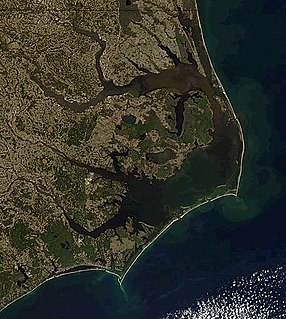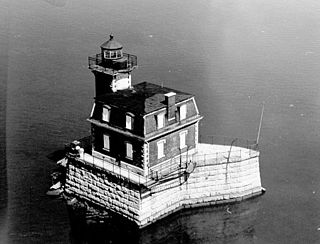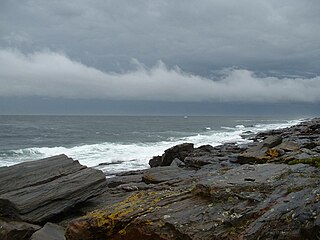
Monhegan is an island in the Gulf of Maine located in Lincoln County, Maine, United States. A plantation, a minor civil division in the state of Maine falling between unincorporated area and a town, it is located about 12 nautical miles (22 km) off the mainland. The population was 64 at the 2020 census. The plantation comprises its namesake island and the uninhabited neighboring island of Manana. The island is accessible by scheduled boat service from Boothbay Harbor, New Harbor and Port Clyde. Visitors' cars are not allowed on the island. It was designated a National Natural Landmark for its coastal and island flora in 1966.

Lubec is a town in Washington County, Maine, United States. It is the easternmost municipality in the contiguous U.S. and is the country's closest continental location to Africa.

The St. Croix River is a river in northeastern North America, 71 miles (114 km) in length, that forms part of the Canada–United States border between Maine (U.S.) and New Brunswick (Canada). The river rises in the Chiputneticook Lakes and flows south and southeast, between Calais and St. Stephen. It discharges into Passamaquoddy Bay, in the Bay of Fundy.

Machias Seal Island is an island in disputed water between the Gulf of Maine and the Bay of Fundy, about 16 km (10 mi) southeast from Cutler, Maine, and 19 km (12 mi) southwest of Grand Manan Island, New Brunswick. Sovereignty of the island is disputed by the United States and Canada. The Canadian Coast Guard continues to staff a lighthouse on the island; the first lighthouse was constructed there in 1832.

Boon Island is a barren rocky island in the Gulf of Maine 6 mi (9.7 km) off the coast of York, Maine. The island, which is approximately 300 ft (91 m) by 700 ft (210 m) at low tide, is the site of Boon Island Light, at 137 ft (42 m) high, it is the tallest lighthouse in New England. Numerous vessels have been wrecked on its rocky shoreline. John Winthrop, the English Puritan lawyer and one of the leading figures in founding the Massachusetts Bay Colony mentions passing Boon Island in the 1600s.

Great Duck Island is a small island in the Gulf of Maine, 11 miles (18 km) south of the entrance to Frenchman Bay, not far from Acadia National Park. Along with nearby Little Duck Island and 11 others, it is part of the town of Frenchboro, Maine.

Cape Lookout is the southern point of the Core Banks, one of the natural barrier islands on the Atlantic coast of North Carolina. It delimits Onslow Bay to the west from Raleigh Bay to the east. Core Banks and Shackleford Banks have been designated as parts of the Cape Lookout National Seashore.

Bass Harbor is a village in Hancock County, Maine, United States. It is within the town of Tremont on Mount Desert Island, and near Acadia National Park. With its well-protected natural harbor, it ranks as one of the most lucrative lobster-producing ports in the state. Bass Harbor Head Lighthouse lies at the mouth of the harbor. The village is also the departure point for Maine State Ferry Service transport to Swans Island and Frenchboro.

The Ladies Delight Light is a small lighthouse on Lake Cobbosseecontee, in Winthrop, Maine, United States. It was constructed in 1908 and is believed to be the only active inland waters lighthouse in Maine. The tower is 25 feet (7.6 m) tall, and is equipped with a solar powered high-intensity marine beacon. It operates every night of the year. At the time of its construction, it was the only inland lake lighthouse east of the Mississippi River. It was listed on the National Register of Historic Places in 1984.

The Hudson–Athens Lighthouse, sometimes called the Hudson City light, is a lighthouse located in the Hudson River in the state of New York in the United States. The light is located between Hudson and Athens, closer to the Hudson side. Constructed in 1874, it marks a sandy ridge known as Middle Ground Flats and also acts as a general aid to navigation of the river. The station is built on a granite caisson with a unique shape designed to protect it from ice floes and river debris. The dwelling is constructed in the Second Empire architectural style, with a mansard roof. It is considered to be virtually a twin of the Stepping Stones Light in Long Island Sound, which was constructed just a few years later.

The Machias River is a 60.0-mile-long (96.6 km) river in Maine, USA. It flows through Washington County in the eastern part of the state, from Fifth Machias Lake, passing the town of Machias and emptying into Machias Bay.

Sakonnet Light, built in 1884, is a sparkplug lighthouse near Sakonnet Point, Little Compton, Rhode Island, on the eastern side of the state.

Two Lights State Park is a public recreation area occupying 41 acres (17 ha) of headland on Cape Elizabeth, Maine, that offers views of Casco Bay and the Atlantic Ocean. The state park, which opened in 1961, is named after the twin Cape Elizabeth Lights, although there are no lighthouses in the park itself. In addition to rocky headlands, the park includes the remains of a World War II–era seacoast battery bunker and a fire control tower. It is managed by the Maine Department of Agriculture, Conservation and Forestry.

Isle au Haut Light, also called Robinson Point Light, is a lighthouse located at Robinson Point in Isle au Haut, Maine. The lighthouse was established in 1907.

Bishop and Clerks Light is a lighthouse located in open water on Bishop and Clerks Rocks, about two nautical miles south of Point Gammon in Hyannis, Massachusetts.

Moose Peak Light is a lighthouse on Mistake Island, just east of Great Wass Island, Maine at the southern entrance to Eastern Bay and five nautical miles southeast of Jonesport. It was first established in 1827. The present structure was built in 1851. Automated since 1972, the light was sold at auction in January 2013 to a private owner from Connecticut.

Two Bush Island Light is a lighthouse on Two Bush Island, on the channel of the same name, the southwestern entrance to Penobscot Bay, Maine. The two bushes for which the island was named have long since vanished. The lighthouse was established in 1897. The keepers were removed when the light was automated in 1964. Afterward, the Two Bush Island fog signal was operated by the keepers at nearby Whitehead Light Station, who also monitored the light. The keeper's house was destroyed in 1970 as a Green Beret demolition exercise. In the summer of 2000, the light was converted to solar power. The lighthouse itself continues to be a navigation aid, but is only visible by boat or from the air. In 1998, the lighthouse became the property of the U.S. Fish and Wildlife Service.
McEvers Island is an uninhabited fluvial island in the Illinois River. Approximately 1 mile (1.6 km) long, it is legally part of Montezuma Township within Pike County in the U.S. state of Illinois. The island, at Mile 48.5, is often used as a landmark by commercial and pleasure boaters traversing the river. Boaters often anchor or tie up in the narrow, sheltered channel east of the island, bordering the Scott County Illinois mainland.

















